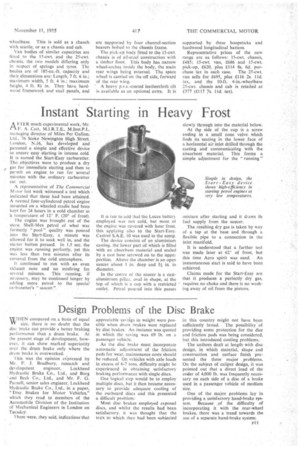Design Problems of the Disc Brake
Page 125

If you've noticed an error in this article please click here to report it so we can fix it.
WHEN compared on a basis of equal size, there is no doubt that the disc brake can provide a better braking performance than a drum brake. At the present stage of development, however, it can show marked superiority over the drum brake only where the drum brake is overworked.
'[his was the opinion expressed by Mr. F. I. Bradbury, research and developrnent • engineer, Lockheed Hydraulic Brake, Co., Ltd., and Borg and Beck Co., Ltd., and Mr. F. G. Parnell, senior sales engineer, Lockheed Hydraulic Brake Co., Ltd., in a paper, "Disc Brakes for Motor Vehicles," which they read to members of the Automobile Division of the Institution of Mechanical Engineers in London on Tuesday.
There were, they said, indicationOthat appreciable savirigs in weight were possible when drum brakes were replaced by disc brakes. An instance was quoted in which the saving was 69 lb. on a passenger vehicle.
As the disc brake must incorporate automatic adjustment of the friction pads for wear, maintenance costs should be reduced. On vehicles with axle loads in excess of 6-7 tons, difficulty might be experienced in obtaining satisfactory braking performance with single discs.
One logical step would be to employ multiple discs, but it then became necessary to provide adequate cooling of the outboard discs and this presented a difficult problem: Most disc brakes employed exposed discs, and whilst the results had been satisfactory. it was thought that the tests to which they had been subjected in this country might not have been sufficiently broad. The possibility of providing some protection for the disc and friction pads was being considered, but this introduced cooling problems..
The authors dealt at length with disc design, in which material, shape and construction and surface finish presented the three major problems. On the subject of caliper design, it was pointed out that a direct load of the order of 4,000 lb. was frequently necessary on each side of a disc of a brake used in a passenger vehicle of medium size.
One of the major problems lay in providing a satisfactory hand-brake system. Because of the difficulty of incorporating it with the rear-wheel brakes, there was a • trend towards the use of a separate hand-brake system.
































































































































































































































































































